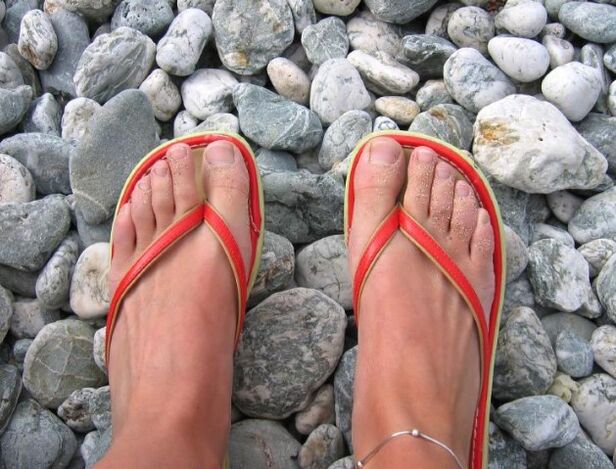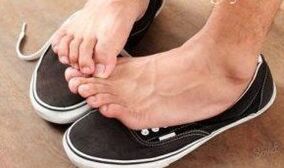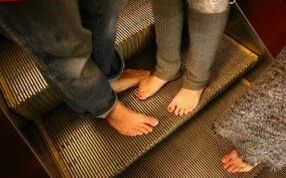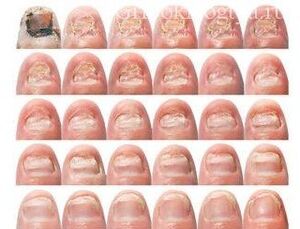Fungus nail is a fairly dangerous phenomenon that can advance, destroying the entire nail plate. In the early stages of development, mushrooms can be invisible to the eyes, however, its negative impact on the structure of the nail plate is intensified. How to recognize nail fungus and how to treat yourself, given the phase of the disease, we will further analyze.

There are several signs that help determine the presence of fungal lesion of nail plates:
- Release the nails - you can check when cutting the edge of the nail. If in the process is nod to crush, do not cut, this is the first symptom of the presence of fungus and clear occasions to see a doctor.
- Nailboard thickening, mainly on hypercheralatosis (compression) occurs due to harmful fungus effects that can disrupt the integrity of fiber for nails, which is why the latter changes in qualitative and quantitative form.
- Use the nail and its cut under the skin - such a phenomenon can cause not only wearing narrow shoes, but also fungal lesions that change nail plate, providing the wrong location.
- Changing the color of the nail (from pale yellow to brown) - occurs as a result of the destruction of the active nail components and protein flip during destruction.
- The presence of a white plate - fungal spores penetrate deep into the root of the nail, and also came to the surface, which is dangerous for a wide infection of all the toes.
The first signs that the nail has lost its health and has problems caused by the active fungus activity, are:
- Loss of gloss and surface gloss;
- a slight yellow nail;
- Extensive outer-footing of the entire foot, the appearance of red dots filled with transparent liquid;
- unpleasant smell of legs, especially after abundant sweating;
- Crossing the skin on the heel and sole, extensively rough.
These symptoms indicate different leg problems, so it is better not to ignore the consultation of the doctor. Early diagnosis is greatly facilitating the treatment process, guaranteeing complete recovery.

Healthy legs on your feet: norm and deviation
To turn off or identify the presence of fungal diseases, you must examine your own legs, fingers and nails. The following indicators should be maintained:
- The leg leg is smooth, without corn, corn and seal.
- The skin of the leg is uniform, without cracks and stains.
- There is no redness and itch, especially between your fingers.
- The nail plate is flat, plain, transparent.
- Nail bed, the surface with the shine is well visible.
If there are deviations from the stated standards, and the legs have an unpleasant stylish, the consultation of doctors and the Pathogen presence survey is needed.
Risk factors for fungus development on feet
Fungia infection can occur in absolutely any place, including house slippers. So that happens enough to have:
- Weak immunity that is unable to restrain active fungus reproduction;
- Increased leg sweats, due to irregular selected and poor shoes;
- Presence of cutting in the nail area with unsuccessful cutting of nail or cuticle;
- Insufficient foot hygiene, as well as shoes;
- Frequent visits to public places where there is a high risk of infection: city baths, saunas, solarium, swimming pool, local beach;
- Excessive use of cosmetics (varnishes, nail extension, refreshing sprays and leg gels), which lead to the death of local immunity.
Separate types of fungi have a different latent period during which the disease is not manifested.
You can infect fungi in two ways:
- Contact - direct contact from the sick person to healthy: personal hygienic objects, public places, carrying other people's shoes.
- Contact - Infection arises due to the active development of these fungi that are in the body of each person. In certain situations (for example, a sharply reduction in immunity), their number increases and the body cannot fully control independently.
The most common people in the following categories are subject to fungal lesions:
- children with thinner layer of leather;
- people suffering from HIV infection;
- with increased foot sweating;
- The presence of chronic diseases that inhibit the immune system.

If there are upper indicators, the nail condition on the legs and stops as a whole must be carefully monitored, paying due attention to hygiene.
Distinguishing fungal nail disease
In medicine, it is the concept of "fungal nail damage" because mushrooms of various species can act as a pathogen. Most often such mushrooms are on foot nails as:
- Dermatophytes - a group of mushrooms that manifest in the form of yellow spots or white vertical stripes. The infected nail gradually loses strength and shape, after which the cavity becomes lifeless and easily removes from the nail bed.
- Yeast lesions - arise as a result of the active activity of the mushroom of the genus Candide. The nail itself is thinner, and R Perilin roller Rumen and swollen. It can be manifested as an independent disease with frequent long-term colds and impaired immunity.
- Molds - are located mainly on the surface of the nail, changing its color to greenish, brown or white shades.
It is impossible to determine the couch agent of fungal diseases, because the same fungi, when exposed to different aggregate factors, can manifest differently. Therefore, it is impossible to start treatment, because every type of mushroom has its antifungal medications that negatively affect the life of pathogens. Therefore, when diagnosing the smallest deviations from the norm, you must consult a doctor, as well as the test for the attendance of the fungus.
Phases of fungal damage on their feet
The process from the moment the infection to complete destruction of nail slab is called the stages of the disease stream. Select them 5:
- Infection - fungus enters the surface of the nail, excreting through the cuticle into the nail bed.
- The incubation period (from 3 days up to 5 months) - the activity of mushrooms is minimal, but it is intensified by lightning speed when all conditions are created for this: Immunity is weakened, there is a wet melting medium, no wet melting, no appropriate hygiene. Outward, the incubation period is not manifested in any way.
- Home Phase - The number of fungus is so large that it can have a negative effect on the sustainability of the nail. Nailboard edges gradually become yellow from edges to nail bed. The nail acquires a matte shade, a pink healthy color disappears, the shine disappears from the surface. In this case, the dry leather of the toes were observed.
- The active course phase - the mushroom population reaches the maximum, which allows you to infect other nail plates, which received disputes via contact. Hyperkeratosis has improved - increased production of keratin fibers, influenced by fungal activity. In this case, the nail is compacted, noticeably bulk above the finger surface.
- The last phase - is determined by the murder of nail plate as a result of the lesion not only the nail, but also near soft tissues. The entire nail surface has a yellow or brown shade, a looseness that is accompanied by painful sensations was observed.
With the Grand Category Infection, local symptoms can also be joined:
- Dysbiosis in the form of chair disorders;
- Increasing body temperature;
- Leg pain, intensifying during movement;
- Confession connection.
All of the above events help determine exclusively phase of off -chomicosis course. To identify the pathogen, you will need to take a special analysis that indicates the exact genus and type of fungus caused by onychomicosis.
How and what to treat treatment

You need to understand that the key to successful treatment is the correct diagnosis, which is impossible to do at home at home. Only a doctor, based on the results of the analysis, can identify the gender of mushrooms, as well as to choose the appropriate treatment.
For many, the mystery remains why, the antifungal medicine purchased in the pharmacy does not help. There are many reasons and explanations for that. First, an antifungal medicine based on the generator was selected initially. Second, fungus treatment is a complex event consisting of:
- Local therapy - Applying antifungal medications to the nail surface.
- Oral antifungal pills that can suppress fungus development and reduce their number from within.
- Immunity drugs that "force" the body to produce a sufficient number of immune troles that are constantly fighting fungus.
- Hygiene legs compliance - the legs are washed 2-3 times a day, with cold water and soap, after which they dried a towel. The nail cuts every 3-5 days.
- Carrying shoes made of real skin, as well as cotton bedding.
Excluding at least one of these 5 points, the recovery process will withdraw more months or even become unsuccessful. Only a comprehensive treatment will allow you to completely resolve the fungi, as well as excluding the risks of the relapse manifestation.
Recipes for traditional medicine, which are so difficult to cure nail fungus in most cases are inefficient. The result will appear only when the above recommendations will be added to combat fungal nail lesions.
Therefore, it is not difficult to determine the presence of fungi on leg nails. It is enough to implement the inspection of nail plates and all the fingers in general, comparing them to images that indicate the presence of fungi. Treatment is considered efficient and correct only when performed under the control of experts. Self-help can cause a lot of negative consequences for health, as well as a complicated disease treatment.
















